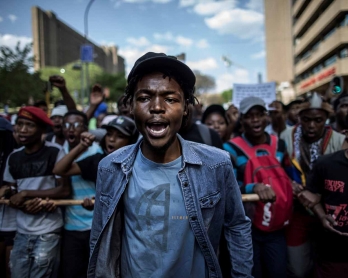The rumble at the gates
Fleury-Merogis, France -- I’ve covered dozens and dozens of protests in the eight years that I’ve worked as a news photographer. But the protest by prison guards at the huge Fleury-Merogis prison in France was something else.
Prison guards are not your average protesters. Even when compared with youth from the ‘banlieue,’ the notorious ghettos of discontent around Paris. Especially at Fleury-Merogis, the largest prison in France and in Europe, housing 4,000 souls. These guys spend their days watching over criminal offenders at the overcrowded facility. After six guards were injured recently during skirmishes with the prisoners, they called for a strike and in mid-April blocked access to the prison. I was there to cover the protest.
 Not your average protesters. (AFP / Geoffroy Van Der Hasselt)
Not your average protesters. (AFP / Geoffroy Van Der Hasselt)I got there in the late afternoon to find several hundred guards on the sole road leading to the prison. The atmosphere was quite congenial, but you could tell that these guys meant business. Under sunny skies, they prepared for the eventual confrontation with the police who were bound to be sent in to clear passage to the penitentiary.
They moved huge trash containers into the road.
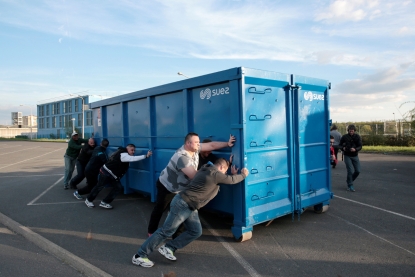 (AFP / Geoffroy Van Der Hasselt)
(AFP / Geoffroy Van Der Hasselt)They piled up heaps of tires.
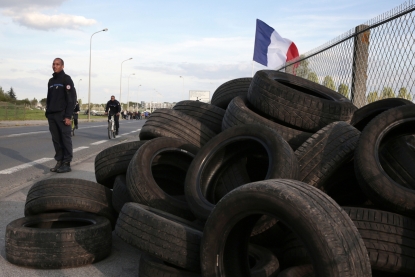 (AFP / Geoffroy Van Der Hasselt)
(AFP / Geoffroy Van Der Hasselt)They readied containers with petrol to set these barricades on fire.
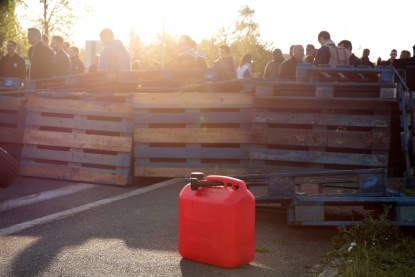 (AFP / Geoffroy Van Der Hasselt)
(AFP / Geoffroy Van Der Hasselt) (AFP / Geoffroy Van Der Hasselt)
(AFP / Geoffroy Van Der Hasselt)
In short, these guys were not fooling around and they were ready. Down to the patches that some of them wore -- a fierce black feline scowling and baring its claws with the words “The penitentiary administration is angry.”
 (AFP / Geoffroy Van Der Hasselt)
(AFP / Geoffroy Van Der Hasselt)But the atmosphere was still quite relaxed and easy-going. One guy handed me a mask to put over my mouth in case of tear gas, as I had forgotten to take mine at the office.
Around 8 pm, a union guy named Marcel got up to motivate his troops.
“You are going to sob when you’re in the middle of the gas! They’ll caress you with their batons! It’ll tickle, maybe as far down as your privates, but don’t worry about it! Always keep an eye on your colleagues!”
 Union leader Marcel Duredon (c) motivates the troops as darkness falls.
(AFP / Geoffroy Van Der Hasselt)
Union leader Marcel Duredon (c) motivates the troops as darkness falls.
(AFP / Geoffroy Van Der Hasselt)Around 9 pm, the first barricade was set alight. Some prison guards posed in front of the flames for the cameras.
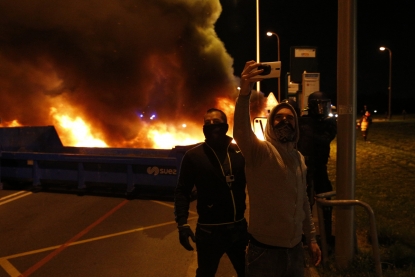 (AFP / Geoffroy Van Der Hasselt)
(AFP / Geoffroy Van Der Hasselt)Suddenly we heard a rhythmic sound. The sound of police batons hitting police shields in unison. The silhouettes of around 50 police in riot gear came into view against the reddish light coming from the flames. They were also preparing for battle.
The guards gathered behind the flaming barricade and shouted insults at the cops.
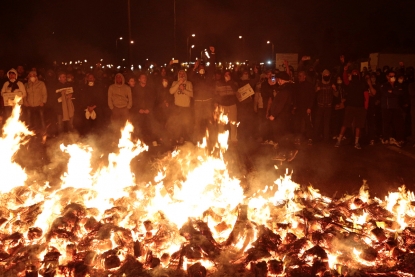 (AFP / Geoffroy Van Der Hasselt)
(AFP / Geoffroy Van Der Hasselt)Confrontation was inevitable and ended up being quite violent.
The guards grabbed each other by the arms, forming a human chain.
Tear gas seemed to rain down -- from canisters to hand-held sprays. Between the tear gas and the flames, the scene was apocalyptic.
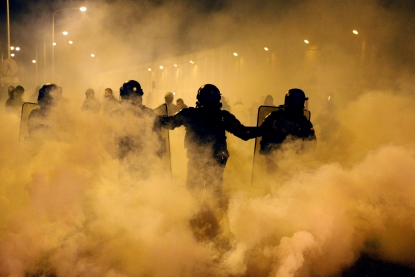 (AFP / Geoffroy Van Der Hasselt)
(AFP / Geoffroy Van Der Hasselt)“Not into the fire! Not into the fire!” chanted the guards. As the police advance made them retreat, they were getting dangerously close to the second barricade and the heat coming from its flames became more and more unbearable.
They tried to take advantage of their numbers to push back the police despite being pummeled by their batons. But the gamble didn't pay off and they were forced to retreat further. “The state against the state!” they shouted.
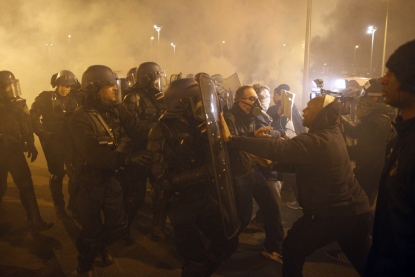 (AFP / Geoffroy Van Der Hasselt)
(AFP / Geoffroy Van Der Hasselt)They had set up four barricades in all, with the fourth one inside the prison grounds, just in front of the entry gates.
At this point, firefighters were on the scene, extinguishing the lit barricades, which added fog and steam to the whole scene.
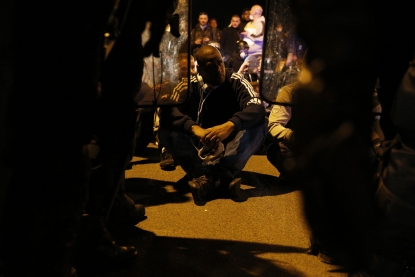 (AFP / Geoffroy Van Der Hasselt)
(AFP / Geoffroy Van Der Hasselt)The guards, their backs against the proverbial wall, began to hit the metal gates of the prison. I wondered if the prisoners inside could hear what was going on, or if they were watching the clashes on TV and what they thought of the whole thing.
Around 11 pm, the guards ended their protest by holding a sit-in and I took advantage of the calm to send my photos. One of them came over to me. He told me that the majority of the prisoners here hit first and ask questions later, so it was impossible to reason with them. And that the guards could no longer frisk prisoners after family visits, so often family members are able to pass to them phones, drugs and even weapons.
I got home late, glad for the chance to have covered something so sensational. And also glad to cover something a bit less stimulating, like the French president making a visit to a region near Paris. Or maybe a demonstration in the banlieue.
This blog was written with Yana Dlugy in Paris.
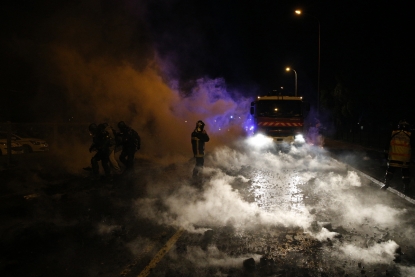 (AFP / Geoffroy Van Der Hasselt)
(AFP / Geoffroy Van Der Hasselt)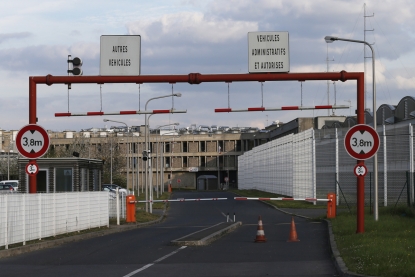 (AFP / Geoffroy Van Der Hasselt)
(AFP / Geoffroy Van Der Hasselt)





